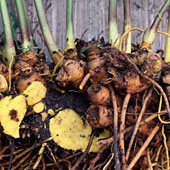
Goldenseal
Introduction
This fact sheet provides basic information about the herb plant or part of a plant used for its flavor, scent, or potential therapeutic properties. Includes flowers, leaves, bark, fruit, seeds, stems, and roots. goldenseal-common names, uses, potential side effects, and resources for more information. Goldenseal is a plant that grows wild in parts of the United States but has become endangered by overharvesting. With natural supplies dwindling, goldenseal is now grown commercially across the United States, especially in the Blue Ridge Mountains.Common Names
goldenseal, yellow rootLatin Names
Hydrastis canadensisWhat It Is Used For
- Historically, Native Americans have used goldenseal for various health conditions such as skin diseases, ulcers, and gonorrhea.
- Now, goldenseal is used for colds and other respiratory tract infections, infectious diarrhea, eye infections, and vaginitis (inflammation or infection of the vagina). It is occasionally used to treat cancer.
- It is also applied to wounds and canker sores, and is used as a mouthwash for sore gums, mouth, and throat.
How It Is Used
- The underground stems or roots of goldenseal are dried and used to make teas, liquid extracts, and solid extracts that may be made into tablets and capsules.
- Goldenseal is often combined with echinacea in preparations that are intended to be used for colds.
What the Science Says
- Few studies have been published on goldenseal's safety and effectiveness, and there is little scientific evidence to support using it for any health problem.
- Clinical studies on a compound found in goldenseal, berberine, suggest that the compound may be beneficial for certain infections—such as those that cause some types of diarrhea, as well as some eye infections. However, goldenseal preparations contain only a small amount of berberine, so it is difficult to extend the evidence about the effectiveness of berberine to goldenseal.
- NCCAM is funding research on berberine, including a study to understand the mechanism by which it may act against tumors.
Side Effects and Cautions
- Goldenseal is considered safe for short-term use in adults at recommended dosages. Rare side effects may include nausea and vomiting.
- There is little information about the safety of high dosages or the long-term use of goldenseal.
- Although drug interactions have not been reported, goldenseal may cause changes in the way the body processes drugs, and could potentially increase the levels of many drugs. However, a study of goldenseal and indinavir, a drug used to treat HIV infection, found no interaction.
- Other herbs containing berberine, including Chinese goldthread (Coptis trifolia) and Oregon grape (Mahonia aquifolium), are sometimes substituted for goldenseal. These herbs may have different effects, side effects, and drug interactions than goldenseal.
- Women who are pregnant or breastfeeding should avoid using goldenseal. The berberine in the herb may cause the uterus to contract, increasing the risk of premature labor or miscarriage. Berberine may also be transferred through breast milk, causing life-threatening liver problems in nursing infants.
- Goldenseal should not be given to infants and young children.
- Tell your health care providers about any complementary and alternative practices you use. Give them a full picture of what you do to manage your health. This will help ensure coordinated and safe care.
Sources
- Goldenseal (Hydrastis canadensis). In: Coates P, Blackman M, Cragg G, et al., eds. Encyclopedia of Dietary Supplements. New York, NY: Marcel Dekker; 2005:297-308.
- Goldenseal. Natural Medicines Comprehensive Database Web site. Accessed on July 6, 2007.
- Goldenseal (Hydrastis canadensis L.), Berberine. Natural Standard Database Web site. Accessed on July 3, 2007.
- NCCAM National Institutes of Health






